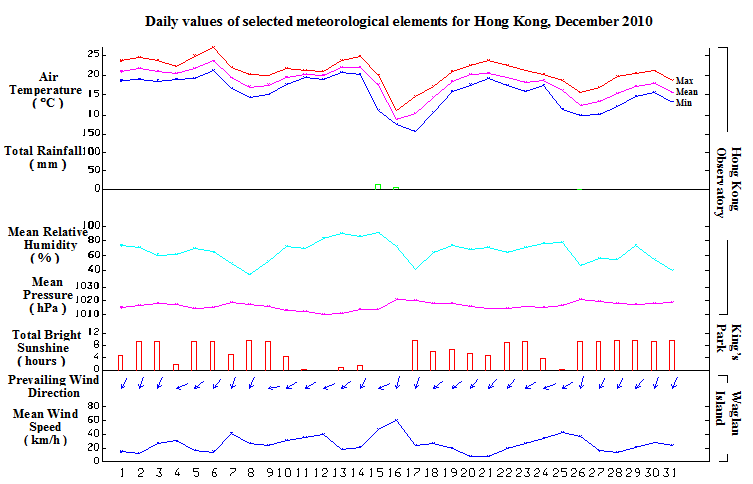|
Despite several cold episodes in the month, the mean temperature of December 2010 was 18.1 degrees, 0.3 degrees above normal. It was mainly due to the high daytime temperatures in generally fine and dry weather brought by the dry winter monsoon. While there were seven cold days (daily minimum temperature at 12.0 degrees or below) and five days with frost reported, there were 22 days with maximum temperatures shooting up to 20.0 degrees or higher in the month. The lowest temperature recorded on 17 December was 5.8 degrees, the lowest for December since 1999; and the highest temperature recorded on 6 December was 26.8 degrees, the highest for December since 1968.
The total rainfall in December 2010 was 18.4 millimetres, only about 53 percent of normal. The annual rainfall for 2010 was 2371.7 millimetres, close to the normal figure of 2382.7 millimetres.
A ridge of high pressure covering southern China brought generally fine and dry weather to Hong Kong for the first six days of the month. With abundant sunshine, the mercury on 6 December rose to 26.8 degrees, the highest of the month.
Following the passage of a cold front over south China coastal areas and arrival of the winter monsoon on 7 December morning, the weather became appreciably cooler and drier. It remained cool and very dry on 8 and 9 December with a minimum relative humidity of about 20 percent. With moderation of the winter monsoon, local temperatures started to rise on 10 December. The weather turned cloudy on 11 December with light rain patches setting in on 12 December. A humid easterly airstream brought mist and fog to Hong Kong in the following two days. Locally, visibility in the harbour fell to below 1000 metres in fog in the morning of 14 December.
In northern China, cold air associated with an intense winter monsoon spread southward across the country and reached Guangdong on 15 December. Local temperatures fell sharply in rain during the overnight period from 15 to 16 December, bringing very cold weather to Hong Kong. The minimum temperature on 17 December morning dropped to 5.8 degrees, the lowest of the year. The dry continental airstream cleared the clouds and the weather became fine and dry on 17 December. With moderation of the winter monsoon, temperatures began to rise on 18 December but inland temperature remained on the low side due to radiation cooling effect with the mercury at Ta Kwu Ling falling to 0.2 degrees, levelling the record low for December registered in 1999.
A moderate northeast monsoon prevailed from 19 to 23 December, bringing mainly fine and dry weather with haze to Hong Kong. Daytime temperatures rose to above 20 degrees during the period.
The weather turned cloudy with sunny intervals on 24 December and there remained to be some haze. A cold front over southern China moved southward and crossed the coast on 25 December, bringing rain and cold weather to Hong Kong. The mercury fell to 9.8 degrees on 26 December morning and the sky cleared up under the influence of the dry winter monsoon which maintained a fine and dry weather for the ensuring four days. It remained cold with frost in the morning on 27 and 28 December while temperatures rose in general until 30 December. The arrival of a replenishment of the winter monsoon brought cooler and very dry weather to Hong Kong on the last day of the month.
|
